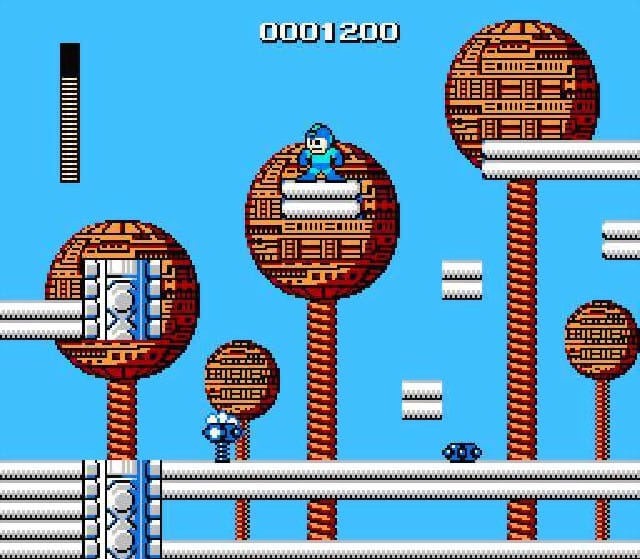
(Review archived from January 27, 2015)
Mega Man was the first game that I ever heard about via word of mouth. Bear in mind that this was before the internet, before orchestrated video game advertising campaigns, and largely before journalistic media coverage of console gaming was officially a ‘thing’ (this would have been somewhere around the time that Nintendo Fun Club was transitioning into Nintendo Power proper). So there I was sitting in 7th grade Algebra class. Two guys with whom I was vaguely familiar were sitting behind me whispering in hushed tones about an NES game. I remember two distinct things about their conversation. The first bit was that they described in detail how an enemy called ‘Electric Man’ (sic) could be easily defeated using the weapon from ‘Scissor Man’ (sic). The second bit was that they described this game as being the video game version of The Running Man. If you’re not familiar, The Running Man is a 1987 Schwarzenegger flick set in a near future dystopia which features a handful of ‘theme based’ villains including (but not limited to) ‘Subzero’ who utilizes ice based attacks, ‘Dynamo’ with electric powers, and ‘Buzzsaw’ who … uh … uses a buzzsaw. Had I carried with me then the same sort of gaming knowledge I have now, I would have turned around to inform them that, “Actually, Smash TV is much closer to The Running Man in both plot and theme,” which would have likely earned me an atomic wedgie for my troubles. Come to think of it, Smash TV hadn’t even been released at the time, so it might have also required a working knowledge of time travel. At any rate, I left algebra class that day with two urgent directives in mind. 1) Play this ‘Mega Man’ game as soon as possible and 2) watch The Running Man. Years later Mega Man remains as an iconic timeless classic whereas The Running Man … remains firmly entrenched as a product of its time.

You can’t talk about any specific Mega Man game without some mention of the bosses, as that is generally what differentiates individual entries in the series and gives each of them something of a unique character. I would say that the standouts here are Cut Man with his iconic scissor head, Ice Man for basically looking like an Eskimo with no embellishment whatsoever, and of course the Yellow Devil, who would go on to appear in several different incarnations of Dr Wily’s castle. Beyond the boss characters, Mega Man also introduced us to one of the most iconic ‘small scale’ video game enemies of all time, the Met (which, if I’m being completely honest, I only just now learned the name of – I have always referred to them simply as ‘hard hats’). So right from the start here at the genesis of Mega Man it was easy to see that the genius of the game (and later of the series as a whole) is built in large part on the strength of its character design.

Unfortunately in hindsight I tend to remember the first Mega Man as being, “that odd one that keeps track of your score”. Further I tend to think of the first Mega Man as being the most difficult of the original NES series, while at the same time not having much in the way of interesting tools or mechanics (i.e. no slide attack, no robot pets, no weapon charges, etc.). Unfortunately this sort of retrospective view of the game robs it of its brilliance. In the context of its time, this game was revolutionary. It is Mega Man stripped down to the absolute bare essentials; Zen and the art of Mega Man if you will. And remarkably it still stands the test of time. The controls remain as razor sharp as they ever were, with just a touch of drift. The strategy of exploiting boss weakness is just as compelling as it’s ever been, and the open level selection allows you to formulate and experiment with this strategy. It’s these core mechanics that have carried the series for years, and it all started here.
Leave a Reply